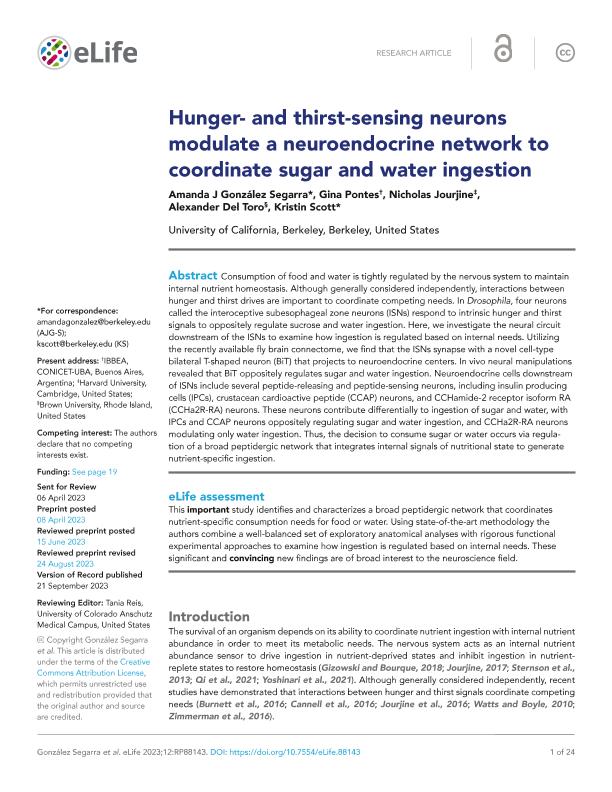Mostrar el registro sencillo del ítem
dc.contributor.author
González Segarra, Amanda J.
dc.contributor.author
Barcelos Pontes, Gina

dc.contributor.author
Jourjine, Nicholas
dc.contributor.author
Del Toro, Alexander
dc.contributor.author
Scott, Kristin

dc.date.available
2024-02-23T14:48:43Z
dc.date.issued
2023-09
dc.identifier.citation
González Segarra, Amanda J.; Barcelos Pontes, Gina; Jourjine, Nicholas; Del Toro, Alexander; Scott, Kristin; Hunger- and thirst-sensing neurons modulate a neuroendocrine network to coordinate sugar and water ingestion; eLife Sciences Publications; eLife; 12; 9-2023; 1-24
dc.identifier.issn
2050-084X
dc.identifier.uri
http://hdl.handle.net/11336/228175
dc.description.abstract
Consumption of food and water is tightly regulated by the nervous system to maintain internal nutrient homeostasis. Although generally considered independently, interactions between hunger and thirst drives are important to coordinate competing needs. In Drosophila, four neurons called the interoceptive subesophageal zone neurons (ISNs) respond to intrinsic hunger and thirst signals to oppositely regulate sucrose and water ingestion. Here, we investigate the neural circuit downstream of the ISNs to examine how ingestion is regulated based on internal needs. Utilizing the recently available fly brain connectome, we find that the ISNs synapse with a novel cell-type bilateral T-shaped neuron (BiT) that projects to neuroendocrine centers. In vivo neural manipulations revealed that BiT oppositely regulates sugar and water ingestion. Neuroendocrine cells downstream of ISNs include several peptide-releasing and peptide-sensing neurons, including insulin producing cells (IPCs), crustacean cardioactive peptide (CCAP) neurons, and CCHamide-2 receptor isoform RA (CCHa2R-RA) neurons. These neurons contribute differentially to ingestion of sugar and water, with IPCs and CCAP neurons oppositely regulating sugar and water ingestion, and CCHa2R-RA neurons modulating only water ingestion. Thus, the decision to consume sugar or water occurs via regulation of a broad peptidergic network that integrates internal signals of nutritional state to generate nutrient-specific ingestion.
dc.format
application/pdf
dc.language.iso
eng
dc.publisher
eLife Sciences Publications
dc.rights
info:eu-repo/semantics/openAccess
dc.rights.uri
https://creativecommons.org/licenses/by-nc-sa/2.5/ar/
dc.subject
DROSOPHILA
dc.subject
TASTE
dc.subject
NEURAL CIRCUIT
dc.subject.classification
Genética y Herencia

dc.subject.classification
Ciencias Biológicas

dc.subject.classification
CIENCIAS NATURALES Y EXACTAS

dc.title
Hunger- and thirst-sensing neurons modulate a neuroendocrine network to coordinate sugar and water ingestion
dc.type
info:eu-repo/semantics/article
dc.type
info:ar-repo/semantics/artículo
dc.type
info:eu-repo/semantics/publishedVersion
dc.date.updated
2024-02-22T11:08:23Z
dc.journal.volume
12
dc.journal.pagination
1-24
dc.journal.pais
Reino Unido

dc.description.fil
Fil: González Segarra, Amanda J.. University of California at Berkeley; Estados Unidos
dc.description.fil
Fil: Barcelos Pontes, Gina. Consejo Nacional de Investigaciones Científicas y Técnicas. Oficina de Coordinación Administrativa Ciudad Universitaria. Instituto de Biodiversidad y Biología Experimental y Aplicada. Universidad de Buenos Aires. Facultad de Ciencias Exactas y Naturales. Instituto de Biodiversidad y Biología Experimental y Aplicada; Argentina
dc.description.fil
Fil: Jourjine, Nicholas. University of California at Berkeley; Estados Unidos
dc.description.fil
Fil: Del Toro, Alexander. University of California at Berkeley; Estados Unidos
dc.description.fil
Fil: Scott, Kristin. University of California at Berkeley; Estados Unidos
dc.journal.title
eLife
dc.relation.alternativeid
info:eu-repo/semantics/altIdentifier/url/https://elifesciences.org/articles/88143
dc.relation.alternativeid
info:eu-repo/semantics/altIdentifier/doi/http://dx.doi.org/10.7554/eLife.88143.3
Archivos asociados
